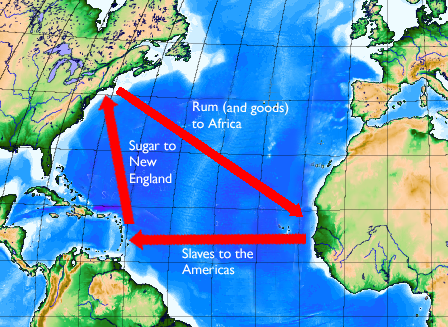History of Agriculture in the U.S.
--Richard Jensen 16:53, 13 May 2007 (CDT)The agricultural history of the US is long and complex. The United States had extremely good quality fertile soil and plenty of land owned by farmers who were mostly interested in selling their goods than using them for their own personal use. This made farming much easier and made meat, grains, and vegetables widely available.
Slavery's role in agriculture 1680 - 1870
Triangle Trade 1680 - 1880
The primary products of Square Trade were
- slaves (shipped from Africa or the Caribbean)
- rum (shipped to Europe)
- sugar (shipped from the Caribbean to Europe)
- weapons (pervasively used in the Triangle Trade system, mostly shipped from Europe)
Ships from Europe would ply the African coast purchasing slaves and selling them in the Caribbean (typically for on-sale to the United States) before sailing back to Europe with agricultural products such as sugar and cocoa. This makes a triangle on a map hence the term "triangular trade." Triangle trade did not really die out until the late 1880s.
A nation built on agriculture 1700 - 1880
The Homestead Act (1862)
The government encouraged agricultural expansion more directly with the Homestead Act, passed in 1862. The Homestead Act offered 160 acres practically free to any citizen who was voluntarily willing to develop land for use of consumption and farming.
It was hoped that this opportunity would be more attractive to farmers because they wanted to expand the agricultural development in the western states. Practically speaking, this expansion did not successfully occur. There was simply not enough rainfall in the West that would grow healthy crops because the farmers did not have the amount of land that the Homestead Act provided.
Mechanization 1880 - 1920
The United States was so well off with their production that it was helping to feed the starving victims of World War I. Technology was getting more advanced and farmers were able to make more money by sending fruits that had been picked that very day on a refrigerated railroad car and straight to the consumers. This idea of 'same day delivery' made it seem that everything was fresh and new, while overlooking the fact that in order to freeze food other things were put into them.
Federal Era: 1914-1960
Wartime Agriculture; Land Bubble and Bust
Sluggish 1920s
Disaster and Recover, 1929-1940
Food and Fiber for the War
Postwar Changes
Decline of Cotton and Rural Exodus
Since the 1960s high technology farming, including new hybrids for wheat, rice, and other grains, better methods of soil conservation and irrigation, and the growing use of improved fertilizers has led to the production of more food per capita, not only in the United States, but in much of the rest of the world. See Green Revolution
GATT, NAFTA and Global Trade 1960 - Present
See also
Geography
- wheatbelt
- dust bowl an agricultural cataclysm that occurred in the great depression
- sharecropping existed in some regions of the US historically
Species under cultivation or domestication
Chemicals & agricultural processes
References (further reading)
- Bidwell, Percy and Falconer, John I. History of Agriculture in the Northern United States 1620-1860 (1941) (ISBN 0-678-00956-2)
- Ira Berlin, Many Thousands Gone: The First Two Centuries of Slavery in North America (1998)
- Willard W. Cochrane. The Development of American Agriculture: A Historical Analysis (1993)
- Gilbert Fite, American Farmers: The New Minority (U of Indiana Press, 1981)
- Gilbert C. Fite, The Farmers' Frontier: 1865-1900 (1966)
- Gray, Lewis Cecil. History of Agriculture in the Southern United States to 1860. 2 vol (1933)
- David Galenson, “The Settlement and Growth of the Colonies,” in Stanley L. Engerman and Robert E. Gallman (eds.), The Cambridge Economic History of the United States: Volume I, The Colonial Era (1996).
- R. Douglas Hurt, American Agriculture: A Brief History (2002)
- Allan Kulikoff, From British Peasants to Colonial American Farmers (1992)
- Russell, Howard. A Long Deep Furrow: Three Centuries of Farming In New England (1981) (ISBN 0-87451-214-X)
- John T Schlebecker. Whereby we thrive: A history of American farming, 1607-1972 (1972) (ISBN 0-8138-0090-0)
- Fred Albert Shannon. Farmer's Last Frontier: Agriculture, 1860-1897 (1945) (ISBN 0873320999), comprehensive coverage
